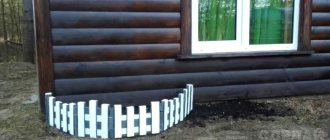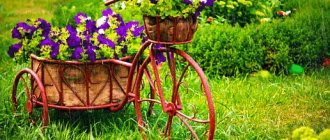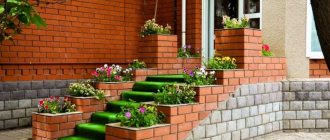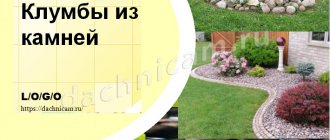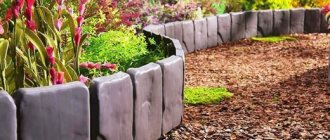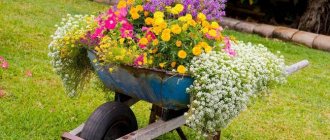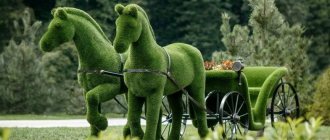Wattle is a fence that is made by intertwining flexible rods of various branches. A wicker fence looks great on a site created in a natural style. Flower beds fenced with wicker structures also look impressive.
The weaving method for making fences has been used by our ancestors since ancient times. Nowadays, wattle can be made not only from branches, but even from materials such as PVC or wood. Wood fences are quite durable; they perform not only a decorative, but also a protective function.
Decorative wattle fence for a fence or flower bed can be made with your own hands from almost any flexible material:
- Reed and cattail. For the fence, long bundles of reeds with a shoot thickness of up to 5 cm are used. If the reeds are dried under the influence of the sun, the wattle fence turns out to be golden in color. Light green reeds are obtained by drying them in the shade of a canopy.
- Vine is the long branches of bushes and trees. Very often, the vine is used to weave flower beds and internal fences that zone the area. The most suitable for a low fence will be rods with a thickness of about 2 cm, and if the fence is high, then the diameter is 2-3 cm. Before starting work, the material from the vine is processed: the bark is removed from the rods, they are steamed and treated with an antiseptic to make them more flexible.
- The oldest and most popular material for weaving is willow. Flexible and very durable willow branches are used to weave not only baskets and bodies, but also fences for flower beds and hedges. Before work, willow twigs are also steamed. And if you treat a living willow hedge with an antiseptic drug and replace the garden soil with sandy soil in the places where the material comes into contact with the drainage, this will significantly extend the service life of such a natural fence.
- As mentioned above, a wicker fence can be built from PVC and wood.
Advantages and disadvantages of a wicker flower bed
A flowerbed in the form of a wicker attracts attention with its originality. To know how profitable it is to create it, you need to understand its pros and cons.
The advantages of wicker borders for flower beds can be characterized by four facts:
- A basket-shaped fence fits effectively into poor and rich landscape design. The flowerbed is succinctly combined with the architectural ensemble and is suitable for growing simple and exotic varieties of flowers.
- It is economical to create a basket. There is no need to purchase materials. The owner uses what is at hand.
- Wicker wicker is an environmentally friendly design.
- It’s easy to weave a basket yourself.
Of the shortcomings, only one point stands out. After a season of use, baskets lose their attractive original appearance. This is due to the harmful effects of weather conditions, mechanical stress, and careless care of the flowerbed by the owners.
Preparing to create a fence
Before weaving the fence, the vine is given flexibility using a “steam bath”. You can also leave the raw materials in warm water for several hours so that they gain moisture and become more flexible.
If the fence is constructed from shoots that have been recently cut, then the leaves do not have to be removed from them. Pine branches intended for support are cleared of bark.
To prevent them from rotting, it is recommended to treat their bottom with an antiseptic or tar.
It is also necessary to remove the bark from the willow vine.
Selection of weaving material
The classic material for weaving a basket is wicker. The more flexible the rods are, the easier it is to work with them. Twigs of willow, dell, birch or willow are good for work. From fruit trees, twigs are taken from apple, dogwood or raspberry trees. Excellent results are obtained when using grapevines.
The rods are cut with pruning shears. Minimum length – 600 mm. The vines are sorted by thickness. Rods with a diameter of 0.6 to 15 mm are used to weave the sides of the basket. A vine 15-30 mm thick is used for stakes, around which the braid is wound.
Harvesting of vines is carried out in the fall. You can cut twigs at other times of the year, but not at the beginning of summer. At this time, the vine is still immature and will break when bent.
Advice! The best vines for baskets are willow and willow. Grape vines are not inferior in quality.
From artificial materials, old linoleum cut into strips is used for weaving baskets. Any flexible hose or wire will do.
Which raw materials to choose?
You don’t have to buy raw materials for braiding; you can find it yourself. A wicker fence is made from reeds, hazel, or vines, but most often flexible branches of a willow vine are used, because they are the easiest to weave.
Varieties of wicker flower beds-baskets
Conventionally, wicker flower beds are divided into two types:
- Ground wicker fences for flower beds are available in large and small sizes. The design resembles a fence. The shape of the basket is given at your discretion: round, rectangular, oval or complex polygonal. Even though the basket is installed on the ground, it can be moved to another location if necessary. The braid is made without a bottom. For transportation, the fence is simply lifted, the soil from the flowerbed remains in place. After installing the basket, it is again filled with soil.
- A hanging wicker flowerbed resembles a flowerpot suspended from the ceiling of a shed or open veranda.
When creating a hanging braid, take into account 4 rules:
- The fastening should allow the flowerpot to rotate freely around its axis. The basket is periodically turned by hand to ensure uniform sun illumination of the flowers.
- Flowers for pots are selected that are not demanding to care for. Petunia and pansies are considered a good option.
- Almost all house flowers have developed roots. To prevent them from displacing soil from the basket during growth, it is made with a volume of at least 10 liters.
- Braid is unable to retain water during irrigation. The flower pots are equipped with a pallet. During irrigation, useful substances are washed out of the soil along with water. Flowers need to be fed more often.
General care for flowers in pots is no different from the care of plants growing above ground.
If we compare the two varieties, then a wicker fence for a flower bed is most often erected by summer residents with their own hands. Sometimes such a basket is complemented with a wicker trellis. Climbing plants are spread along the support, forming a beautiful wall near the flower bed.
Flowerbeds-baskets differ in the type of weaving:
- with a horizontal vine arrangement;
- with vertical arrangement of rods.
In both options, the basis of the braid is stakes driven into the ground. They are placed at a distance of 300-400 mm from each other.
With horizontal weaving, the rods are twisted between the stakes, laid parallel to the ground. To connect, the ends of the vine are cut at an angle, joined together, and tied together with wire or strong bark. Each new rod is inserted from the back of the peg. The procedure lasts until the height of the braid is equal to the tops of the stakes.
When weaving vertically, additional horizontal slats are attached to the stakes. The vine is twisted between them, positioned perpendicular to the ground. The weaving process is similar. Only the arrangement of the rods is different.
Experienced craftsmen create a multi-tiered wicker flowerbed or use a complex type of weaving, for example, oblique and checkerboard. In the first option, the vine lies at an angle relative to the stakes. In checkerboard weaving, the rods are laid horizontally, but they do not wrap around every pillar, but from 2 to 4 pieces are passed through. The result is a complex pattern.
Unusual baskets are woven from twigs of different trees. They differ in color, which allows you to create beautiful designs. To achieve this goal, the vine can be painted.
Advice! If you drive fresh willow or willow pegs into the ground for braiding, they will sprout with regular watering. You will get a beautiful green hedge.
A little about decoration
In the classic design of the fence, sunflowers, the heads of which elegantly hung on it, and snow-white daisies were usually planted next to it. But the range of crops that harmonize with a wicker fence is much larger. These can be perennial and alpine aster, late-blooming chrysanthemum, delphiniums, various varieties of cornflower, as well as gillyflowers, mimulus, dahlias, marigolds, nasturtiums and decorative (and not only) sunflowers.
And the wattle can also be an excellent support for climbing plants such as beans (edible and decorative), sweet peas (the flowers look like colorful butterflies), morning glory, kobea, decorative pumpkin and others. The leaves and flowers of these crops will look great against the background of intertwined branches and shoots.
To add some color, you can hang a variety of pottery (plain and glazed) on the tops of the supports and build a bench from logs and stumps next to the fence.
And here you can learn how to make an original flowerbed-clock in your garden plot.
How to make a flowerbed in the form of a basket with your own hands
To create a flowerbed-basket yourself, you first need to stock up on materials. The second important issue is understanding the craft of weaving. There is nothing complicated about this. You can learn how to weave a vine using the master class presented in the video:
Flowerbed-basket made of vines
An inexperienced person can weave a basket for ground installation with a vertical and horizontal arrangement of rods. More often than not, the second option is more acceptable. To begin with, it is better to take the simplest shape of a flowerbed: a circle or a rectangle.
To weave a flowerbed-basket from willow, follow these steps:
- In order for the ground flowerbed to have increased strength, the vine is harvested 15 mm thick. Pegs are taken with a diameter of about 3 cm. The tools used are a knife, pruning shears, and a mallet.
- A place is selected for the flowerbed. A contour is marked on the site using a construction cord. Using a shovel, remove the top layer of soil with the roots of weeds.
- Measure the perimeter of the flowerbed and calculate the required number of stakes. The parameter depends on the installation step. If the vine is short, then the distance between the pegs is reduced to 250 mm.
- The length of the stakes is calculated taking into account the fact that half will go into the ground. The protruding ground part determines the height of the fence.
- One end of the stakes is sharpened with a knife.
It will be easier to drive them into the ground with a mallet. The workpieces are treated with protective impregnation. Additionally, you can open it with varnish. The stakes are driven in at the same distance from each other. The docking location is determined by the length of the vine. Where the lock will be, an additional support is driven in at a distance of 50 mm from the main peg. Advice! Sometimes stakes made of metal rods are used for reliability. This type of flowerbed fencing will last longer, but looks less attractive. - The vine for weaving is cut to a minimum length of 600 mm. The rods should cover 3-4 spans. To increase flexibility, the vine is soaked in water before weaving. The bark is removed from the rods and treated with protective impregnations.
- Horizontal weaving begins from the bottom of the supports from the ground. The vine is twisted in a zigzag around the stakes. Weaving starts from the thick end of the rod and ends with the thin end. At the junction, the ends of the vine are cut at an angle of 45°. The branches are tied to the stakes with wire.
When the flowerbed-basket made of willow twigs is ready, the bottom is covered with film, the prepared substrate is poured, and flowers are planted.
DIY flowerbed-basket made from boards
The boards are not suitable for weaving due to their lack of flexibility. However, you can create a flowerbed in the shape of a basket from them. The structure is made rectangular. For supports, it is advisable to choose oak or larch boards. Hard wood lasts longer in the ground. The slats for the sides are cut along the length of the fence. It is optimal to make the thickness of the workpieces 10-15 mm so that they can bend a little.
To build something like a wicker fence for a flowerbed with your own hands, drive supports around the perimeter of the marked area. The pitch between the pillars is determined empirically so that the planks can bend between them. Each plank is fixed to the support with self-tapping screws. At the corners, mounting angles are used for joining.
The finished structure is treated with protective impregnation. The braid is opened with varnish. To give a beautiful shade, stain is used.
Flowerbed basket made of linoleum
The advantage of a basket made of artificial materials is its long service life. Beautiful fences for flower beds are made from old linoleum. First, the material is cut into strips 100 mm wide. The supports are driven into the ground from a plastic pipe. The ribbons are intertwined with horizontal laying using the vine method. To keep the rows more firmly, the linoleum is fixed to the posts with a stapler.
Weaving is carried out to the top of the supports. To give the end of the braid an aesthetic appearance, it is framed with a strip of linoleum, covering the ends of the pipes. Upon completion of weaving, they begin to decorate the flowerbed in the form of a basket with decorative elements. First of all, a handle is attached from a plastic pipe and wrapped in burlap for beauty. You can guide the weaving stems of vines along the handle. The side of the flower bed is decorated with large artificial flowers, figurines of animals or fairy-tale characters.
Flowerbeds from old baskets
The option of creating a flower bed is suitable for lazy people who do not want to weave. An old basket is used as a basis. For above-ground installation, the bottom will need to be removed. It is carefully cut from the basket so that the weaving does not fall apart. The fencing frame is installed in a prepared place. The braid is pinned to the ground with wire or pegs are driven in end to end.
It is better to use a small old basket instead of a flowerpot. It is suspended by the handle from a support. The flowerbed can simply be installed on a stand. A multi-tiered structure is constructed from several baskets. Flowers are planted undersized and unpretentious. Pansies and marigolds grow well.
Living wattle fence and solid board fence: photo examples of original structures
For the average person, erecting a fence is a relatively simple task. First you need to collect the branches and sort them into 2 categories. The thick ones are used to build the base, while the thin ones perform the direct function of a fence. You can go further and make a living fence and then adjust the length of the branches and the direction of their growth. The fence should be decorated in a rustic style. Such a fence will grow upward and thicker. Branches that become too tall are cut off or sent lower. The living fence practically does not protect the territory, but it can be used as a zone separator within the site.
In a living wicker fence, the vine grows vertically.
To collect living vertical wattle fence, you will first need to prepare the soil. For this purpose, places for support pillars are selected. We select the distance between the elements within 1-1.5 meters. Then the supports (4-5 centimeters thick) are driven into the ground 40 or 50 cm.
To facilitate this process, the lower ends of the supports should be pre-sharpened. Next, we attach the transverse joists. Using wire, we install thinner rods in several rows (3 are enough at a height of 1.5 meters). Then it's time to plant the branches. Shoots up to 3 cm thick are immersed in the soil by 30 cm. The distance between the stems should not be less than 10 and more than 30 cm. Living wattle will grow and make the composition denser.
Note! The branches should be placed with a slight slope to make it easier to change the composition if necessary.
The hedge provides shade, coolness and rustles the leaves.
Steps for creating a wicker fence from boards yourself:
- Initial calculations;
- Marking and installation of support pillars;
- Installation of fencing;
- Finishing.
Weaving using boards involves creating various edges and transitions. The result is an interesting “designer” structure. To install a fence with your own hands, you will first need to make calculations.
The first step is to mark the corners of the fence. You will need to install pillars in the corners of the plot and provide wicket and gate areas (they are usually combined). Then the step between the supports is calculated.
Note! If the pillars are concrete or wooden with a thickness of 8-10 cm, they can be placed at 3-meter intervals, thin supports (5-7 cm) - up to 2.5 m.
Wicker fence made of boards.
Next, preparatory work is carried out: markings are made, pillars are installed. The main stage is the installation of the boards themselves. You need to mount it from below first, bending the boards one by one. This task will require two people. The boards are attached to the posts using galvanized nails. Work is carried out immediately along the entire perimeter: first, the first row is laid everywhere, then the second, etc.
An excellent alternative to a regular wicker fence is a plastic fence. This type of fencing is not afraid of time. They are also attractive to look at - they look modern and original. Plastic can have high strength, which will protect the product from minor mechanical impact.
Plastic wattle.
One of the most popular materials is polyvinyl chloride (PVC). Fences, partitions and other objects are made from it. PVC is resistant to corrosion, rotting, extreme temperatures and temperature changes, and direct sunlight.
Note! Dirt is easily washed off from a plastic fence; special solutions are not needed.
Plastic structures are lightweight, so transportation and installation will be quick and without complications. An untrained person can install such a fence. A fundamentally important feature of a material such as PVC is its resistance to fire. Disadvantages of installing a plastic fence: strong impact on it will leave defects that will be clearly visible; high price.
Caring for a wicker flower bed
In the spring and at the beginning of the first summer month, a flower garden in a basket at the dacha looks modest. Viola usually begins to bloom first. Petunia blooms at the end of June. The flowerbed becomes lush and “plays” with the colors of flowers until the end of summer.
The care required is the same as for a simple flower bed. The only requirement is increased watering. The soil in the basket dries out faster. Fertilizers usually include a solution of chicken manure and potassium preparations. After each watering, the soil is loosened and weeds are removed.
Making a fence
First you need to make markings: the boundaries of the future fence are marked with pegs, a rope is pulled between them; The places where the supports will be driven in are indicated.
The distance between the supports should be about 30-50 cm. The greater the weight of the willow vine, the greater the distance the supports can be installed. If the supports bend during weaving, you can fasten them together with wooden poles from above.
- Best Time to Thin Your Yard
Mesh filters. What are they?
Soft windows. What it is?
Usually fences are woven vertically or horizontally.
Ideas for wicker flower beds in the shape of a basket in the country
Peculiarities
Such decorative willows are wicker trees, which are made from a special durable willow rod. Such plantings can be left in pots or transplanted into the ground. Tall shrubs, consisting of intertwined branches, are used to create a more beautiful and interesting landscape design. Such willows can be purchased ready-made; the most common option is the “Willow Danish Roots” sample. It is a small tree made using a special technology of living weaving.
Plastic wattle
An excellent alternative to a regular wicker fence is a plastic fence. This type of fencing is not afraid of time. They are also attractive to look at - they look modern and original. Plastic can have high strength, which will protect the product from minor mechanical impact. One of the most popular materials is polyvinyl chloride (PVC). Fences, partitions and other objects are made from it. PVC is resistant to corrosion, rotting, extreme temperatures and temperature changes, and direct sunlight. Dirt is easily washed off from a plastic fence; special solutions are not needed. Plastic structures are lightweight, so transportation and installation will be quick and without complications. An untrained person can install such a fence. A fundamentally important feature of a material such as PVC is its resistance to fire.
Disadvantages of installing a plastic fence:
- a strong impact on it will leave defects that will be clearly visible;
- high price.


